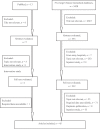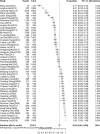A Systematic Review of Antibiotic Prescription Associated With Upper Respiratory Tract Infections in China
- PMID: 27175658
- PMCID: PMC4902500
- DOI: 10.1097/MD.0000000000003587
A Systematic Review of Antibiotic Prescription Associated With Upper Respiratory Tract Infections in China
Abstract
Overuse of antibiotics among patients with upper respiratory tract infection (URTI) is a worldwide problem, and the problem is especially serious in developing countries, such as China. This systematic review is aimed at summarizing previous findings on outpatient prescriptions of antibiotics associated with URTI in China in order to help policymakers and the public understand and tackle the problem.We systematically searched and reviewed studies of antibiotic prescribing patterns for outpatients with URTI in China that were published in Chinese or English before December 31, 2014. The study quality was assessed, and the overall rates of URTI cases prescribed antibiotics were calculated by using random-effects model. Subgroup analyses were performed to explore the potential sources of heterogeneity among studies.We included 45 eligible studies with a total of 52,072 URTI outpatients. The overall percentage of URTI outpatients prescribed antibiotics was 83.7% (95% confidence interval [CI]: 80.6%-86.4%). Of the URTI outpatients prescribed antibiotics, 79.7% (95% CI: 72.8%-85.2%) were prescribed 1 antibiotic, 18.4% (95% CI: 13.6%-24.5%) prescribed 2 antibiotics, and 1.1% (95% CI: 0.7%-1.6%) prescribed 3 or more antibiotics. The rates of antibiotic prescription varied greatly across hospitals and showed a downward trend over time.An extremely high percentage of URTI patients in China were prescribed antibiotics and, the overuse is especially problematic in lower-level hospitals. Although there appears a downward trend, likely attributable to China's recent efforts in curbing antibiotic abuse, greater efforts are needed to promote the rational use of antibiotics.
Conflict of interest statement
The authors have no conflicts of interest to disclose.
Figures


References
-
- WHO. Antimicrobial Resistance: A Global Threat. 2000; http://apps.who.int/medicinedocs/collect/medicinedocs/pdf/s2248e/s2248e.pdfhttp://apps.who.int/medicinedocs/collect/medicinedocs/pdf/s2248e/s2248e.pdf. Accessed April 25, 2016.
-
- Levy SB, Marshall B. Antibacterial resistance worldwide: causes, challenges and responses. Nat Med 2004; 10:S122–S129. - PubMed
-
- Malhotra-Kumar S, Lammens C, Coenen S, et al. Effect of azithromycin and clarithromycin therapy on pharyngeal carriage of macrolide-resistant streptococci in healthy volunteers: a randomised, double-blind, placebo-controlled study. Lancet 2007; 369:482–490. - PubMed
-
- Costelloe C, Metcalfe C, Lovering A, et al. Effect of antibiotic prescribing in primary care on antimicrobial resistance in individual patients: systematic review and meta-analysis. BMJ 2010; 340:c2096. - PubMed
-
- Gwaltney JM. Mandell GL B, Bennett JE, Dolin REBT Principles and Practice of Infectious Disease. The common cold. 4th ed.New York: Churchill Livingstone; 1995. 561–566.
Publication types
MeSH terms
Substances
LinkOut - more resources
Full Text Sources
Other Literature Sources
Medical

